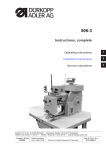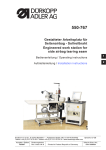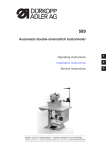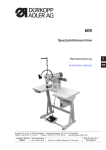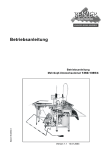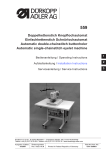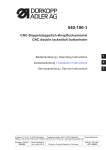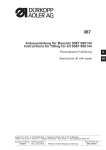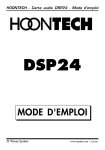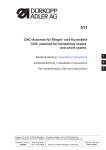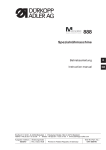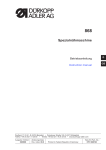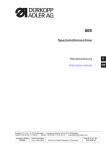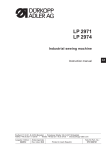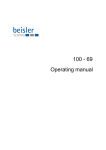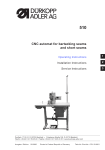Download DURKOPP ADLER 511 - Operating instructions
Transcript
511 CNC-Automat für Riegel- und Kurznähte CNC automat for bartacking seams and short seams Bedienanleitung / Operating Instructions 1 Aufstellanleitung / Installation Instructions 2 Serviceanleitung / Service Instructions 3 Postfach 17 03 51, D-33703 Bielefeld Potsdamer Straße 190, D-33719 Bielefeld Telefon +49 (0) 5 21/ 9 25-00 Telefax +49 (0) 5 21/ 9 25 24 35 www.duerkopp-adler.com Ausgabe / Edition: 08/2009 Änderungsindex Rev. index: 00.0 Printed in Federal Republic of Germany Teile-Nr./Part.-No.: 0791 511001 Alle Rechte vorbehalten. Eigentum der Dürkopp Adler AG und urheberrechtlich geschützt. Jede, auch auszugsweise Wiederverwendung dieser Inhalte ist ohne vorheriges schriftliches Einverständnis der Dürkopp Adler AG verboten. All rights reserved. Property of Dürkopp Adler AG and copyrighted. Reproduction or publication of the content in any manner, even in extracts, without prior written permission of Dürkopp Adler AG, is prohibited. Copyright © Dürkopp Adler AG - 2009 Foreword This instruction manual is intended to help the user to become familiar with the machine and take advantage of its application possibilities in accordance with the recommendations. The instruction manual contains important information on how to operate the machine securely, properly and economically. Observation of the instructions eliminates danger, reduces costs for repair and down-times, and increases the reliability and life of the machine. The instruction manual is intended to complement existing national accident prevention and environment protection regulations. The instruction manual must always be available at the machine/sewing unit. The instruction manual must be read and applied by any person that is authorized to work on the machine/sewing unit. This means: – – – Operation, including equipping, troubleshooting during the work cycle, removing of fabric waste, Service (maintenance, inspection, repair) and/or Transport. The user also has to assure that only authorized personnel work on the machine. The user is obliged to check the machine at least once per shift for apparent damages and to immediatly report any changes (including the performance in service), which impair the safety. The user company must ensure that the machine is only operated in perfect working order. Never remove or disable any safety devices. If safety devices need to be removed for equipping, repairing or maintaining, the safety devices must be remounted directly after completion of the maintenance and repair work. Unauthorized modification of the machine rules out liability of the manufacturer for damage resulting from this. Observe all safety and danger recommendations on the machine/unit! The yellow-and-black striped surfaces designate permanend danger areas, eg danger of squashing, cutting, shearing or collision. Besides the recommendations in this instruction manual also observe the general safety and accident prevention regulations! General safety instructions The non-observance of the following safety instructions can cause bodily injuries or damages to the machine. 1. The machine must only be commissioned in full knowledge of the instruction book and operated by persons with appropriate training. 2. Before putting into service also read the safety rules and instructions of the motor supplier. 3. The machine must be used only for the purpose intended. Use of the machine without the safety devices is not permitted. Observe all the relevant safety regulations. 4. When gauge parts are exchanged (e.g. needle, presser foot, needle plate, feed dog and bobbin) when threading, when the workplace is left, and during service work, the machine must be disconnected from the mains by switching off the master switch or disconnecting the mains plug. 5. Daily servicing work must be carried out only by appropriately trained persons. 6. Repairs, conversion and special maintenance work must only be carried out by technicians or persons with appropriate training. 7. For service or repair work on pneumatic systems, disconnect the machine from the compressed air supply system (max. 7-10 bar). Before disconnecting, reduce the pressure of the maintenance unit. Exceptions to this are only adjustments and functions checks made by appropriately trained technicians. 8. Work on the electrical equipment must be carried out only by electricians or appropriately trained persons. 9. Work on parts and systems under electric current is not permitted, except as specified in regulations DIN VDE 0105. 10. Conversion or changes to the machine must be authorized by us and made only in adherence to all safety regulations. 11. For repairs, only replacement parts approved by us must be used. 12. Commissioning of the sewing head is prohibited until such time as the entire sewing unit is found to comply with EC directives. 13. The line cord should be equipped with a country-specific mains plug. This work must be carried out by appropriately trained technicians (see paragraph 8). It is absolutely necessary to respect the safety instructions marked by these signs. Danger of bodily injuries ! Please note also the general safety instructions. Contents Page: Part 2: Installation Instructions – Class 511 (DAC III) 1. Items delivered . . . . . . . . . . . . . . . . . . . . . . . . . . . . . . . . . . . . . . . . . . . . . . . 3 2. General and transport packaging . . . . . . . . . . . . . . . . . . . . . . . . . . . . . . . . . . . 3 3. 3.1 3.2 3.3 3.4 3.5 3.6 Mount stand and control circuitry cabinet Table tops . . . . . . . . . . . . . . . . . . . . . . . . . . . . . . . . . . . . Frame parts assembly . . . . . . . . . . . . . . . . . . . . . . . . . . . . Complete the table top . . . . . . . . . . . . . . . . . . . . . . . . . . . . Connect the control box to the main switch . . . . . . . . . . . . . . . . Mount the reference value transmitter and the equipotential bonding Adjusting working height . . . . . . . . . . . . . . . . . . . . . . . . . . . . . . . . . . . . . . . . . . . . . . . . . . . . . . . . . . . . . . . . . . . . . . . . . . . . . . . . . . . . . . . . . . . . . . . . . . . . . . . . . . . . . . . . . . . . . 5 5 6 7 8 9 4. 4.1 4.2 4.3 4.4 4.5 Assembly of automatic bartacker Mount the oil pan . . . . . . . . . . . Set up the automatic bartacker . . . Mount the oil lines . . . . . . . . . . . Mount the control panel . . . . . . . Mount the cover . . . . . . . . . . . . . . . . . . . . . . . . . . . . . . . . . . . . . . . . . . . . . . . . . . . . . . . . . . . . . . . . . . . . . . . . . . . . . . . . . . . . . . . 10 11 12 12 13 5. 5.1 5.2 Connect the plug connections to the control box Plug connections at the four-way multiple pin strip . . . . . . . . . . . . . . . . . . . . . . . . . . Wiring . . . . . . . . . . . . . . . . . . . . . . . . . . . . . . . . . . . . . . . . . . . . . . . . . . . . . 14 15 6. Change sewing feet and fabric support plate . . . . . . . . . . . . . . . . . . . . . . . . . . . 16 7. Fit eye protection . . . . . . . . . . . . . . . . . . . . . . . . . . . . . . . . . . . . . . . . . . . . . 17 8. 8.1 8.2 8.3 Convert automatic bartacker 511-213 to General . . . . . . . . . . . . . . . . . . . . . Adjust clamp height . . . . . . . . . . . . . . Change stop position . . . . . . . . . . . . thick fabrics . . . . . . . . . . . . . . . . . . . . . . . . . . . . . . . . . . . . . . . . . . . . . . . . . . . . . . . . . . . . . . . . . . . . . . . . . . . . . . . . . . . . . . . . . . . . . 18 19 19 9. 9.1 9.2 9.3 Oil lubrication Topping up with oil . . . . . . . . . . . . . . . . . . . . . . . . . . . . . . . . . . . . . . . . . . . . . Oil the wicks and the felt part in the oil pan . . . . . . . . . . . . . . . . . . . . . . . . . . . . . . . Oiling the hook path. . . . . . . . . . . . . . . . . . . . . . . . . . . . . . . . . . . . . . . . . . . . . 20 21 22 10. 10.1 10.2 10.2.1 10.2.2 10.2.3 10.3 Setting in motion Standard delivery . . . . . . Software installation . . . . General . . . . . . . . . . . . Loading the program . . . . Dongle update via Internet. Sewing test . . . . . . . . . . . . . . . . 22 23 23 24 26 27 11. 11.1 Additional equipment Sewing light . . . . . . . . . . . . . . . . . . . . . . . . . . . . . . . . . . . . . . . . . . . . . . . . . 28 . . . . . . . . . . . . . . . . . . . . . . . . . . . . . . . . . . . . . . . . . . . . . . . . . . . . . . . . . . . . . . . . . . . . . . . . . . . . . . . . . . . . . . . . . . . . . . . . . . . . . . . . . . . . . . . . . . . . . . . . . . . . . . . . . . . . . . . . . . . . . . . . . . . . . . . . . . . . . . . . . . . . . . . . . . . . . . . . . . . . . . . . . . . . . . . . . . . . . . . . . . . . . . . . . . . . . . . . . . . . . . . . . . . . . . . . . . . . . . . . . . . . . . . . . . . . . . . . . . . . . . . . . . . . . . . . . . . . . . . . . . . . . . . . . . . . . . . . . . . . . . . . . . . . . . . . . . . . . . . . . . . . . . . . . . . . . . 2 2 1 3 4 9 5 8 7 6 1. Items Delivered The items that are supplied depend on your order. Before setup, please check that all the required components are present. This description refers to an automatic bartacker and the individual components which are completely delivered by Dürkopp Adler AG. – 1 Upper part (head) including oil pan “Electro” parts set with: – 2 Control panel – 5 Mains switch – 6 DAC control unit Dürkopp-Adler accessory kit with: – 3 Reel stand – Protective cover (not shown) – – – – 2. 8 7 4 9 Frame (optional) Pedal and rods (optional) Table plate (optional) Drawer (optional) 2 General and transport packaging CAUTION ! The automatic bartacker should only be installed by trained specialists. Transport packing If you have bought an assembled automatic bartacker, the following transport securing devices have to be removed: – Safety straps and battens from the upper machine head, table and frame. 3 4 Four punch marks for Spax screws Punch-marks from the underside (1 x), only at this point 3. Mount stand and control circuitry cabinet 3.1 Table tops The cutouts of self-manufactured table tops must have the dimensions indicated in the sketch. Caution – Risk of Injury ! The table tops must have the required load-carrying capacity and strength. 3.2 Frame parts assembly 2 3 1 2 – Mount the individual parts of the stand as shown in the illustration. – Set the adjusting screw 3 to ensure the stability of the stand. The frame must be resting with all four feet on the floor. Screw pedal 2 on the stand strut 1. – – Align pedal laterally (side-to-side). Shift the pedal sideways so that it is positioned centrally to the oil pan. The stand strut is provided with slotted holes for aligning the pedal. 5 3.3 Complete the table top 6 5 4 – – – – – – 3 2 1 Place the table top on a worktop upside down. Screw the main switch 6 on the underside of the table top on the left. Screw cable duct 5 tight behind the main switch 6. Screw cable duct 2 tight to the left of the lead-through 1. Put the access line 4 in the cable duct. Fasten the access line 4 by means of strain relief 3. 7 – – 6 Place the control box 7 on the underside of the table top and position it in such a way that the side with the four sockets points to the left (towards the thread reel holder). Screw the control box with four screws on the punch-marked spot at the underside of the table top. 3.4 Connect the control box to the main switch CAUTION ! Only trained personnel or electricians may work on the electric equipment of the automatic bartacker. The mains plug must be unplugged! 2 2 1 4 – – Take off the switching knob. Loosen the screw 2 in the knob in order to remove. Remove the cover 3 from the main switch. Unlock the locking bar in drill-hole 4 with a screwdriver in order to remove. – – Run the cable from the control box into the cable duct. Insert the cable in the main switch. – Connect the cable wires from the control box to the screws “T1” and “T2”. Connect the protective-earth conductor of the control box in the main switch. – 5 3 – – – Put the cover on the mains switch again. Put on the switching knob 1 and screw it tight. Put on the cover of the cable duct. 7 3.5 Mount the reference value transmitter and the equipotential bonding 1 6 5 2 4 3 – – – – 8 Screw the reference value transmitter 5 on the stand strut with fixing link 1. Hook the ball mugs of the pedal bars 6 in at the pedal and at the reference value transmitter 5. Screw the potential compensation cable 2 on the fixing link 1. Screw the equipotential bonding cable 2 of the reference value transmitter and the equipotential bonding cable 4 of the sewing machine tight on the control box by means of screw 3. 3.6 Adjusting the working height 2 1 2 The working height is adjustable between 750 mm and 950 mm (as measured to the upper edge of the table plate). – Loosen screws 1 at both legs of the stand. In order to prevent twisting, pull out or push in the table top equally on both sides. The scales 2 at the exterior surfaces of the legs serve as adjusting aid. – Tighten screws 1. 9 4. Assembly of automatic bartacker 4.1 Mount the oil pan 3 2 1 – – 10 Lay oil pan 1 on table top 3. Align it and screw it tight through the two through bore-fits 2 with two wood screws. Insert thread reel holder 1 in the drill-hole of the table top and screw tight with nuts and washers. Mount and align the thread reel arms and the thread guides. The thread reel arms and thread guides must be positioned exactly one above the other. 4.2 Set up the automatic bartacker 4 3 2 1 8 7 6 5 The small parts for setting up the automatic bartacker are included in the accessories kit. – Place the automatic bartacker 1 on the oil pan 4. – Fasten the bartacker on the left and right sides using the fixtures 5 and 8. Screw the fixtures 5 and 8 tight with the screws 9, the sheets 11 and the counter-nuts 10. – Insert the machine head support 6 in the drill-hole of the table top. – Tilt the automatic bartacker sideways. – Run the connecting cables 2 under the table top through the opening 3. – Tilt the automatic bartacker back. 9 9 5 8 10 10 11 11 2 4.3 Mount the oil lines 10 – 4.4 8 Fasten oil lines 8 and 9 in the oil pan with the fitting clip 10. The oil filter must be completely surrounded by the felt. Mount the control panel 4 – – 12 9 3 2 1 Screw on the panel 4 to the automatic bartacker using the angle 3. Lay rubber washers between the mounting angle of the control panel and the cast housing. Run the connecting cable 2 under the table top through oil pan 1. 4.5 Mount the cover 9 8 10 6 – – – Lower the cover 9 onto the retaining spring 10. First lay the cable of the control panel in the gap 1 of the cover. Screw the cover on the automatic bartacker with two screws through the drill-holes 6 and 8. 2 1 13 5. Connect the plug connections to the control box 5.1 Plug connections at the four-way multiple pin strip 6 1 7 2 8 3 9 4 10 5 Connect the plug connections of the automatic bartacker as follows: – Plug 1 -> Step motor, X axis – Plug 2 -> Step motor, Y axis – Plug 3 -> 15-pole plug for control panel BF3 – Plug 4 -> 25-pole plug for clamping-foot magnet (thin connecting cable) – Plug 5 -> 25-pole plug for I/O 21 – 28 (thick connecting cable) – Plug 6 -> 5-pole plug for sewing motor – Plug 7 -> 9-pole plug for sewing-motor incremental transmitter – Plug 8 -> 9-pole plug for pedal – Plug 9 -> 9-pole plug for sewing-motor reference switch – Plug 10 -> 37-pole plug for I/O 1 – 19 14 5.2 Wiring 1 To make the tilting of the machine head possible, make sure that the cables leading from the head through the opening in the table top to either the 15-way multiple pin strip at the control box and to the cable duct are long enough. For this purpose the cables must be laid to form an arc 1 with the help of the cable ties. 15 2 6. Change sewing feet and fabric support plate 2 1 3 6 5 4 3 The automatic bartacker 511 is delivered with standard sewing equipment. If you have received further optional sewing equipment, this has to be mounted as follows: Caution – Risk of Injury ! Turn the main switch off. Change sewing equipment only when main switch is switched off. Disassemble sewing equipment – Unscrew screw 3. – Pull off holder 5. – Take out sewing feet 4 and 6. – Unscrew screw 1. – Take off support plate 2. Assemble sewing equipment – Insert sewing feet 4 and 6. – Place retainer plate 5 and screw tight with screws 3. – Place support plate 2 and screw tight with screw 1. ATTENTION: Danger of breakage ! When changing the clamping foot, be sure to enter the new clamping foot number in the menu “Equipment”. 16 7. Fit eye protection 4 3 2 1 Caution – Risk of Injury ! The automatic bartacker must not be operated without eye protection. – Screw the eye protection 1 on the automatic bartacker 4 with fixing bracket 2 and the two screws 3. 17 2 8. Converting automatic bartacker 511-213 to thick fabrics 8.1 General From the factory, the automatic bartacker 511-213 is set for the processing of normal fabrics. If thicker fabrics are to be sewn on the machine, the following alterations have to be made: · The stop position of the machine has to be altered. From the factory, the positioning of the machine is done in the position “Thread lever 3 in the top dead centre = stop position 0” (needle bar stands somewhat deeper). When converting to thicker fabrics, the positioning is done in the position “Thread lever 15° before the top dead centre = stop position -15” (needle bar stands higher). 18 8.2 Adjust clamp height ATTENTION: Danger of breakage ! When converting the automatic bartacker to thicker fabrics, you must adjust the clamp height. – 8.3 Refer to the service instructions in chapter 6.3 for adjusting the clamp height. Change stop position The stop position is set in the technician mode in the menu “Machine configuration” via the menu item “Stop position” (refer to the operating instructions in chapter 8.5.4.1). 2 19 9. Oil lubrication Caution – Risk of Injury ! Oil can cause skin rashes. Avoid prolonged skin contact. If oil or grease contacts your skin, wash yourself thoroughly. CAUTION ! The handling and disposal of mineral oils is subject to legal constraints. Dispose of used oil at an authorized collecting station. Protect your environment. Take care not to spill any oil. Fill up the oil reservoirs exclusively with lubricating oil DA-10 or equivalent oil with the following specification: – Viscosity at 40° C: 10 mm 2 /s – Flash point: 150° C DA-10 can be purchase at the DÜRKOPP-ADLER AG sales branches under the following parts numbers: 250-ml container: 9047 00001 1 1-litre container: 9047 00001 2 2-litre container: 9047 00001 3 5-litre container: 9047 000014 9.1 Topping up with oil 1 2 3 Oil reservoir for lubricating the automatic bartacker – Fill up oil through drill-hole 1. This will fill up both reservoirs. – Use the two inspection glasses 2 and 3 to check the oil level. The oil level must be above the red marking of both inspection glasses. 20 9.2 Oil wicks and felt part in the oil pan 1 2 CAUTION ! When assembling the machine and after a longer stop, the wicks and the felt parts 1 and 2 have to be soaked with some oil. – – – – – – – Tilt automatic bartacker sideways. Put a drop of oil on felt 1. Tilt back automatic bartacker. Screw off cover of winder. Put a drop of oil on felt 2. Place on cover of winder and screw tight. 21 2 9.3 Oiling the hook path 2 1 Oiling the hook path – Open hook cover. – Put a drop of oil between driver 2 and path 1. – Shut hook cover. CAUTION ! When assembling the machine and after a longer stop, the hook path and the connecting rod have to be oiled. Caution – Risk of Injury ! Turn the main switch off. Oil the automatic bartacker only when switched off. 10. Setting in motion 10.1 Standard delivery The automatic bartackers are delivered with the following clamping feet: Class 510-211 with clamping foot no. 1 Class 510-212 with clamping foot no. 8 Class 510-213 with clamping foot no. 2 ATTENTION: Danger of breakage ! If the standard clamping foot is changed, the corresponding clamping foot number has to be specified. 22 10.2 Software installation 10.2.1 General Loading specific sewing software in the DACIII control unit is possible with the help of the “Programmed Dongle”. The “Programmed Dongle” has a label indicating the class and software version. Such a load (boot) process can be used to provide individual DACIII control unit with sewing software (first installation) or to install updated machine software. When the machine is delivered, only the test software (allowing the loading of sewing software) is installed in the control unit. The test software offers no further functions. If the test software gets damaged during the loading process, it is no longer possible to load software using a dongle. In such a case, you should use a PC with an upload cable. CAUTION ! Turn off the main switch before connecting the dongle! 2 23 10.2.2 Loading the program – – – Turn off the main switch. Insert the dongle in the X111 socket on the control unit (see illustration) Turn on main switch. The software will be loaded. The loading process takes less than 60 seconds. CAUTION ! Do not remove the dongle during the loading process and do not switch off the machine! (This will damage the software.) – – 24 The machine proceeds with a warm start after the software is loaded. The following screen appears: – Now remove the dongle. – If necessary, confirm the software version by pressing the “OK” key. CAUTION ! The machine software must match the machine class. If the software version differs from the machine class, do not confirm the loading. Switch the machine off and repeat the loading process using the correct software version. The adjustment of the control unit is described in the operating instructions in chapter 8 “Operating the 511 Control Unit". The number of the installed clamping foot must be specified before switching on the bartacker for the first time. – Plug in the power supply plug. – Turn on the main switch. The control unit is initialized. The following menu appears: 2 – – Press the “OK” key. Enter the corresponding number of the clamping foot using keys “ñ “ or “ò “. – Press the “OK” key. – Press the “ESC” key. The screen changes over to the main menu. 25 Note The menu cannot be exited before the clamping foot number has been entered. Invoking the configuration menu is only possible after you have entered the clamping foot number. For the optional equipment, please check the operating instructions (Chapter: Optional Equipment). – 10.2.3 The machine is now ready for use. Dongle update via Internet Dongles can be updated with programs available from the Dürkopp Adler homepage. Go to the “www.duerkopp-adler.com” home page. Click on “Download Area” and then “Software”. There you will find downloadable auxiliary programs and the corresponding machine software. The instructions are also found on this page. They describe the exact procedure for updating the dongle. 26 10.3 Sewing test After completion of the assembly, a sewing test should be made. – Plug in the power supply plug. – Wind up bobbin thread (see operating instructions chapter 7.5) Caution – Risk of Injury ! Turn the main switch off. Thread in needle and bobbin thread only when the automatic bartacker is switched off. – – Thread in needle thread (see operating instructions chapter 7.1). Insert hook thread bobbin (see operating instructions chapter 7.6). – –Turn on main switch. The control unit is initialized. Select the material to be processed. Carry out the sewing test – initially with a slow speed and then continually accelerating. Check whether the bartack pattern corresponds to your required demands. If the requirements are not met, change thread tensions (see operating instructions, chapters 7.2 and 7.7). The adjustments indicated in the service instructions have to be checked too, and corrected, if necessary. Check the oil level at both inspection glasses during the operation of the automatic bartacker. – – – – 27 2 11. Additional equipment 11.1 Sewing light 3 2 1 4 Sewing light 1 (order no. 9822 510026) and table clamp 3 (order no. 9822 510027) are available for the automatic bartacker 511. – Clamp sewing light to table top 2. 5 – – – – 28 Mount the socket adapter kit 5 (order no. 9870 001021). Connect the wires to the terminal L1 and L2 of the power switch (see also chapter 3.4) Connect the protective-earth connection to the power switch. Insert the plug in the socket 4 under the table top.

































